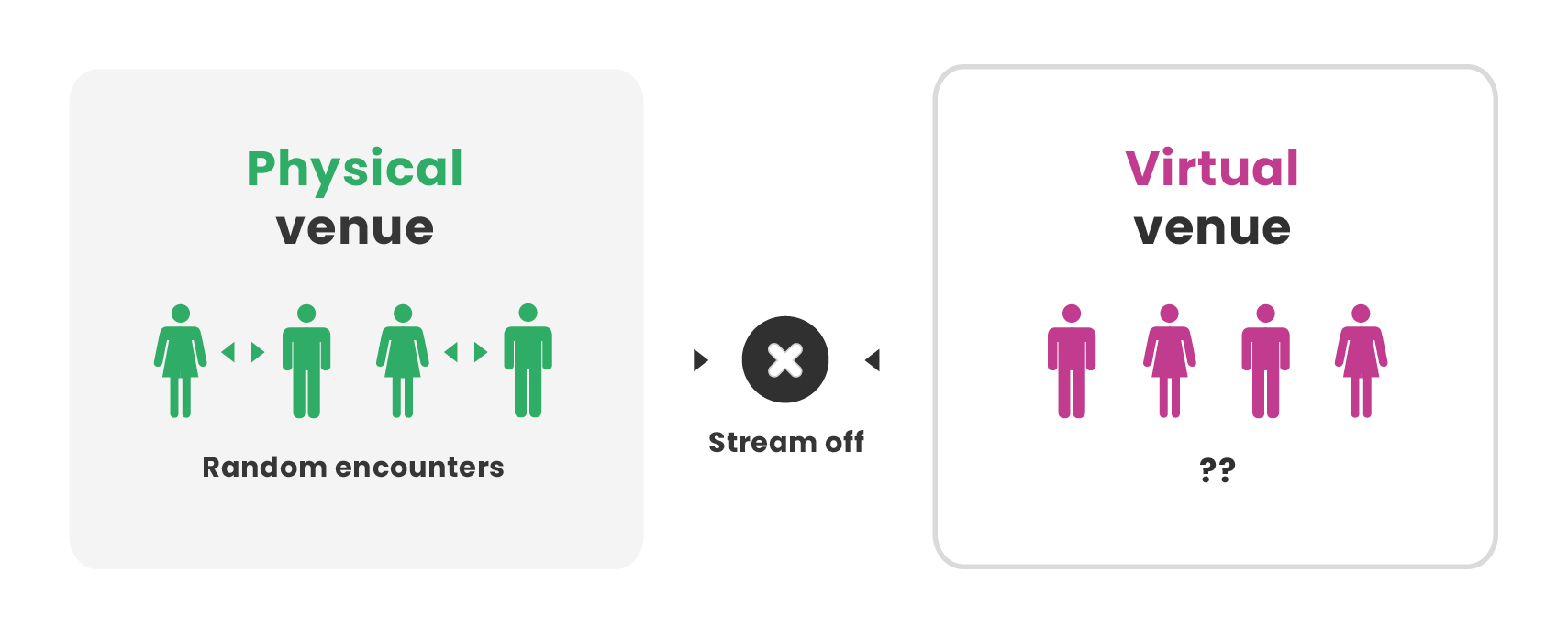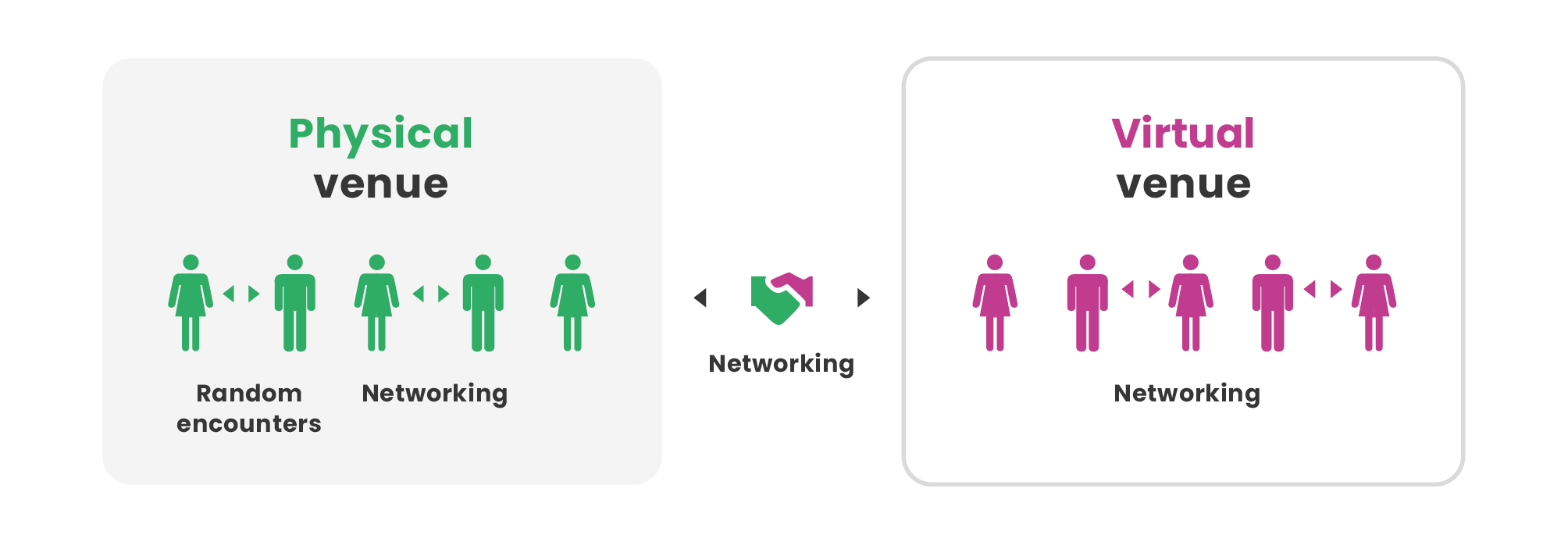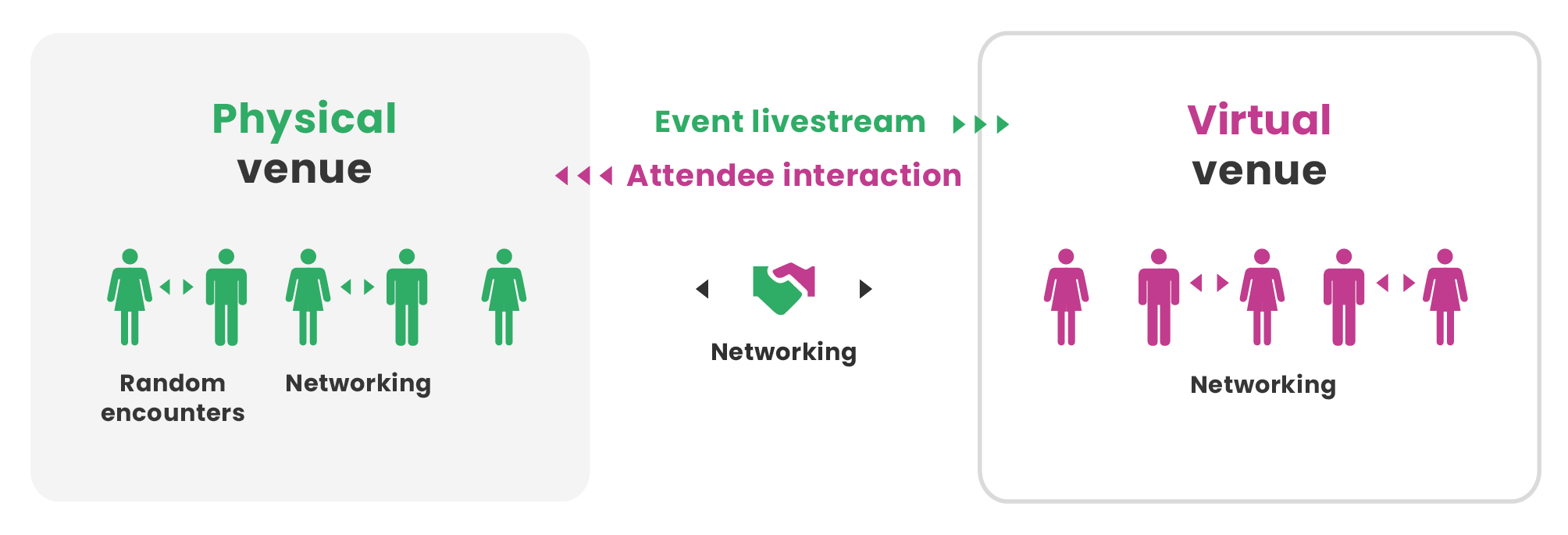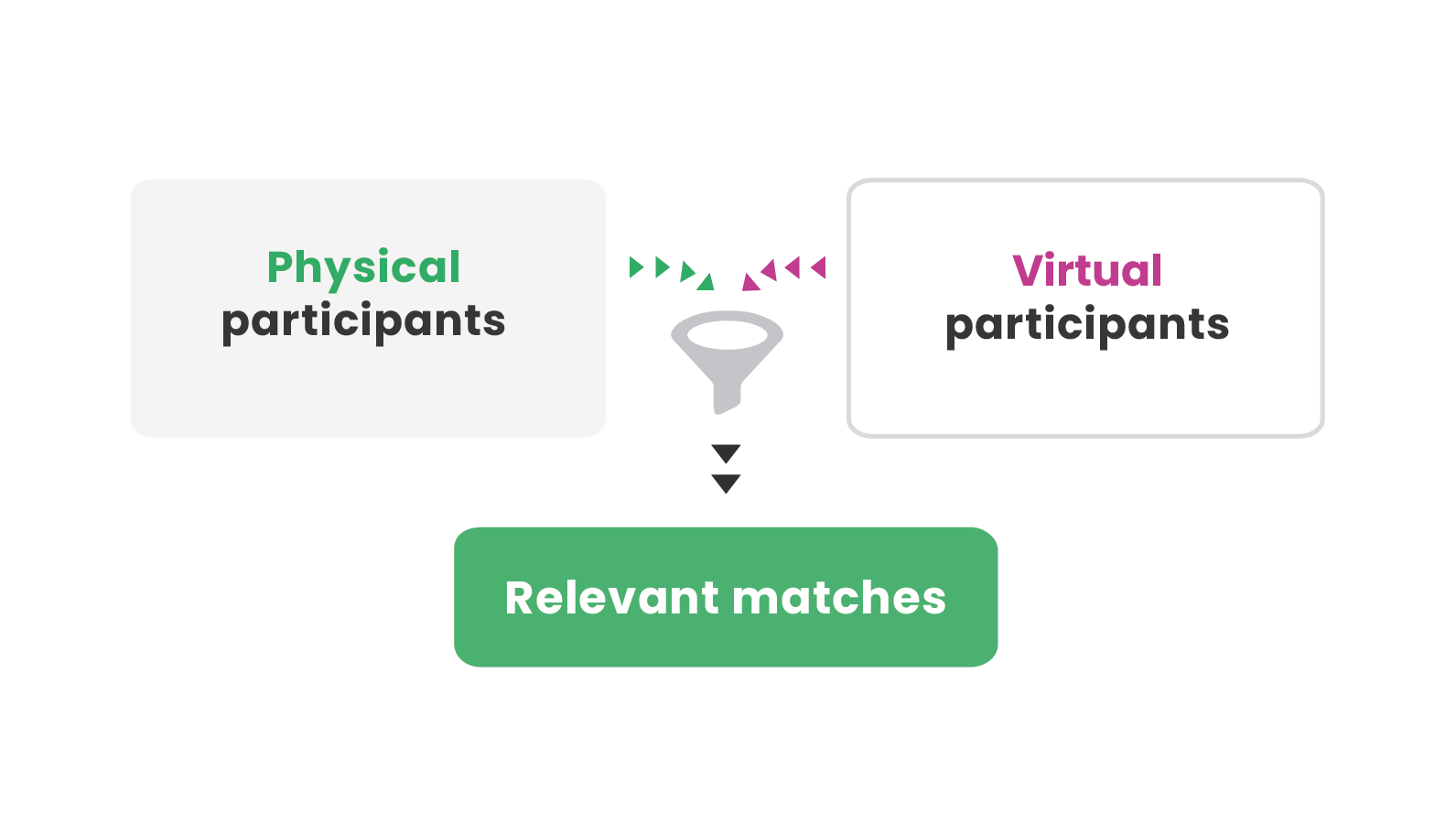Hybrid events are essential to your future event strategy.
It's a bold claim, but hybrid events are already happening and succeeding, maybe even in a location near you.
Hybrid events, while certainly requiring more implementation, offer a ton of benefits that far outweigh the cost, like:
- Expanded reach. From those who haven't heard of you to those who have thought about attending for a while, a virtual component makes participation simple.
- Greater data and analytics. To grow and improve, you need to understand the areas where you thrive and where you lack. Adding a virtual component opens up immense data capture potential for your event.
- Flexibility for your participants. The main draw of your event will always be the experience, and offering a virtual component won't threaten that. Instead, your attendees can join in a way that suits them best.
However, a common question we get is...
How does networking work at hybrid events?
Getting networking right is essential for hybrid events.
Why?
Well, when you host a hybrid event, you are connecting a physical and a virtual event together.
You stream your content from your physical venue to your virtual venue, and the audience interacts with it, via Q&A software, polling software or live chat.
In short, both audiences connect and engage with each other.

However, what happens when your stream ends? Your audience loses that connection.
Your physical audience can rely on random encounters, coffee breaks and more for interactions, but what about your virtual participants?

By adding facilitated networking to the mix, you give real interaction and engagement to your audiences.
It ensures both audiences can break the barriers and connect with anyone, no matter where they are.

Plus, facilitated networking helps save time for both physical and virtual attendees.
Instead of typical 30 minute or 1 hour demo calls, your attendees can have three 15 minute focused meetings in one hour (including 5 minute breaks in between).
Quite simply: Networking is essential to keep your audience engaged, no matter when or where your content is.

So how can you ensure you offer quality networking opportunities for all participants? We've gathered 6 great tips for you in this post.
- Provide a central location for all attendees to meet online
- Offer a matchmaking service for all attendees
- Separate meeting areas for physical and hybrid meetings
- Educate attendees on hybrid meeting best practices
- Leave transition times between meetings
- Facilitate serendipity for virtual participants
And if you struggle with planning virtual and hybrid events, our  includes everything you need to know.
includes everything you need to know.
Let's get into it!
1. Provide a central location for all attendees to meet online
As mentioned above, you need to connect two audiences together.
After all, segmenting your audience makes for a poor networking experience.
But how can you provide one location for both your physical and virtual audience?
Well, the best way is by using a virtual or hybrid event platform that all attendees can access during the event.
Your virtual participants join through their desktop devices, and physical attendees through their mobile devices.
Even if they can’t be together face-to-face, they can still interact with each other and connect in this online forum.
Plus, a good virtual event platform solves many other problems, like:
- Hosting your livestream in a distraction-free environment
- Ensuring attendees have easy access to all your event information
- Giving you the opportunity to send reminders and notifications to your audience
Using a virtual event platform as your central location for all attendees is essential for hybrid events. For networking, of course, but for many other reasons too!
2. Offer a matchmaking service for all participants
Networking is so easy for your physical audience - they have the benefit of social cues, body language, and more to determine context and have a good meeting.
Not to mention, serendipity is in their favor!
Your virtual participants have it a bit tougher. After all, anywhere from 70 to 93 percent of communication is non-verbal, meaning that it can be difficult to communicate effectively while having online meetings - and they need to get a meeting in the first place.
So to ensure your virtual participants have a worthwhile networking experience, you need to help them find relevant meetings.
While physical participants can rely on serendipity and social cues to meet new people, virtual participants are limited to the information they see on their screen.
That means it can be downright awkward to meet new people without knowing a thing about them beforehand.
By offering participants the opportunity to search the attendee list with a meaningful filter - either job title, company, interests or more - you offer them valuable context, which helps them make a better first impression.

Better yet, try facilitated matchmaking, as this proactively provides the most relevant matches for each attendee. No need to search!
3. Provide separate meeting areas for physical and hybrid meetings
It can be tough to have a good meeting during the hubbub of events, which is why we recommend having an area solely dedicated to networking meetings.
And whenever possible, offer a separate meeting area for participants with virtual meetings too.
For a great hybrid meeting area, you’ll require at least:
- Power outlets for charging devices. This prevents last minute panic and delays because of a low battery.
- Solid Wi-Fi. Nothing is more agonizing than trying to have a conversation with someone who is breaking up every 5 seconds.
- Desks, chairs, standing tables, or anything to make the physical participants comfortable. They’ll have a more productive meeting when they’re relaxed.
These are also good additions for your physical meeting area, but not necessary.

Your virtual participants will most likely be participating from the comfort of their home, so your physical participants deserve at least some level of comfort.
Having the meeting area in a quiet, secluded part of your venue (if possible) will ensure that the meeting is a positive experience for both parties.
4. Educate your attendees on hybrid meeting best practices
While most of us are familiar with video conferencing tools by now (perhaps overly familiar), there are a few meeting tips that are still worth mentioning to your audience:
- Ensure Wi-Fi has bandwidth for your meeting. Encourage your participants to keep internet use to a minimum while having meetings. (In other words, don’t stream Netflix while trying to have a conversation!)
- Get into a proper environment. Good lighting can do wonders for a meeting. As well, reducing the reverb in a room improves audio quality.
- Use headphones and a mic if possible. Both participants should use headphones and a mic if possible, as it improves audio quality and ensures that the conversation doesn't disrupt others.
These aren’t necessary, but they will drastically improve the quality of the meeting.
They can focus on learning about each other instead of asking “Sorry, you broke up a bit, could you repeat that?” over and over again.
Also, communicating the benefits of hybrid meetings can boost the connectivity between your two audiences.
Your physical participants may forget there are interesting people to meet virtually - and vice versa.
When you combine the power of meeting the right person with the amazing content you're providing, well, that's the secret sauce to a dynamic event!
5. Leave transition times between meetings
Breaks are essential for good hybrid meetings (and hybrid events in general). Your virtual audience needs structured breaks in the program.
A physical participant has a lot of opportunity to be active, stretch their limbs, and engage with others. One of the many benefits of attending physically!
However, the most your virtual participants need to move to get to their next meeting is their wrist and fingers.
So they need those reminders to get up and stretch their legs, go to the bathroom, or just stare out the window for a moment.
Offering 5 minutes between meetings allow both participants to get to their next meeting, while also ensuring they have some buffer time to keep talking if the conversation is going super well.
6. Facilitate serendipity for virtual participants
It’s important to remember that a hybrid event means you have two separate audiences, and they’ll take different journeys at your event.
And it’s perfectly okay if your audiences interact separately.
For physical attendees, there is watercooler talk, chance encounters and other moments of serendipity that they’ll grab as they happen.
For virtual attendees, however, serendipity needs to be engineered.
Here are some great ways to inject some serendipity for your virtual attendees:
- Structured virtual networking. This could be a speed dating type affair that involves only your virtual participants.
- Virtual breakout sessions.
- Post-stream and end-of-event recaps. While your physical audience mingles between keynotes, offer a structured recap for further virtual engagement.
Bonus tip – keep networking open after your event ends
Your event may end, but the potential for connections doesn’t.
Many virtual event platforms allow you to offer structured networking for a few days after your event program ends.
This allows your physical attendees to travel back home and have a virtual meeting in their own environment.
It also allows all your participants to network on their own schedule, which is a huge benefit and draw of virtual events.
As a rule of thumb, digital platforms and experience benefit more from repeat usage, meaning that stretching your networking over a few days ensures your participants have more interactions with your brand.
Bring your hybrid audiences together
If you don’t connect your physical and virtual audiences together, you aren’t hosting a hybrid event.
You’re livestreaming your physical event, plain and simple.
Audience interaction and participation is essential for a hybrid event, and networking is one of the easiest ways to bring your participants together.
And a good virtual event platform solves the issue of where to gather your attendees and how to connect them.
If you're thinking of hosting a virtual or hybrid event, but don't know where to start,  .
.
Inside you'll find all the essentials to hosting virtual and hybrid events, including how to manage the networking!
Read more
- Virtual events
- Hybrid events
- In-person events
- Event sponsorship
- Event engagement
- Event matchmaking
-
Brella news
-
Brella and Swoogo Partner for Optimized Event Experiences

-
Brella wins the Best Event App in the US & Canada

- START Global partners with Brella for a world-class networking experience
- Brella co-hosts The European Startup Conference to help Ukrainian tech ecosystem
- Next Block Expo partners with Brella for a world-class networking experience
-
- Meet a Brellaneer













